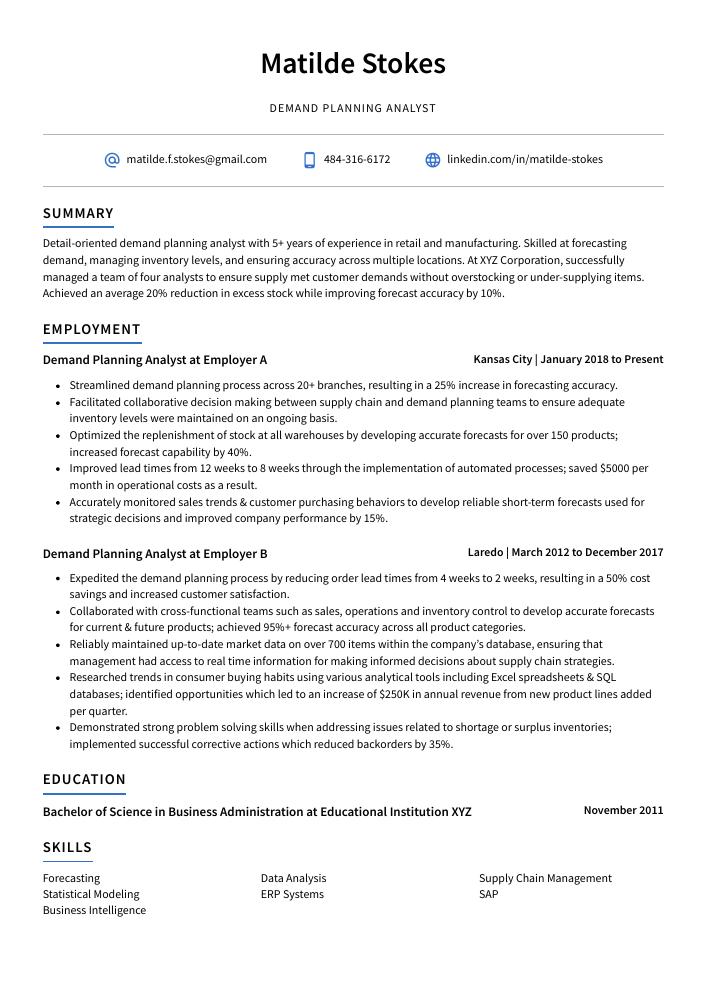Demand Planning Analyst Resume Guide
Demand planning analysts focus on forecasting customer demand and managing the supply chain process in order to ensure that inventory levels are adequate for meeting current and future market needs. They use data analysis, sales trends, predictive analytics, and other methods to determine how much stock should be ordered from suppliers in order to meet expected customer demand.
Your expertise in demand planning and forecasting would be a valuable asset to any business. To make sure hiring managers know who you are, your resume must stand out from the rest of the crowd.
This guide will walk you through the entire process of creating a top-notch resume. We first show you a complete example and then break down what each resume section should look like.
Table of Contents
The guide is divided into sections for your convenience. You can read it from beginning to end or use the table of contents below to jump to a specific part.
Demand Planning Analyst Resume Sample
Matilde Stokes
Demand Planning Analyst
[email protected]
484-316-6172
linkedin.com/in/matilde-stokes
Summary
Detail-oriented demand planning analyst with 5+ years of experience in retail and manufacturing. Skilled at forecasting demand, managing inventory levels, and ensuring accuracy across multiple locations. At XYZ Corporation, successfully managed a team of four analysts to ensure supply met customer demands without overstocking or under-supplying items. Achieved an average 20% reduction in excess stock while improving forecast accuracy by 10%.
Experience
Demand Planning Analyst, Employer A
Kansas City, Jan 2018 – Present
- Streamlined demand planning process across 20+ branches, resulting in a 25% increase in forecasting accuracy.
- Facilitated collaborative decision making between supply chain and demand planning teams to ensure adequate inventory levels were maintained on an ongoing basis.
- Optimized the replenishment of stock at all warehouses by developing accurate forecasts for over 150 products; increased forecast capability by 40%.
- Improved lead times from 12 weeks to 8 weeks through the implementation of automated processes; saved $5000 per month in operational costs as a result.
- Accurately monitored sales trends & customer purchasing behaviors to develop reliable short-term forecasts used for strategic decisions and improved company performance by 15%.
Demand Planning Analyst, Employer B
Laredo, Mar 2012 – Dec 2017
- Expedited the demand planning process by reducing order lead times from 4 weeks to 2 weeks, resulting in a 50% cost savings and increased customer satisfaction.
- Collaborated with cross-functional teams such as sales, operations and inventory control to develop accurate forecasts for current & future products; achieved 95%+ forecast accuracy across all product categories.
- Reliably maintained up-to-date market data on over 700 items within the company’s database, ensuring that management had access to real time information for making informed decisions about supply chain strategies.
- Researched trends in consumer buying habits using various analytical tools including Excel spreadsheets & SQL databases; identified opportunities which led to an increase of $250K in annual revenue from new product lines added per quarter.
- Demonstrated strong problem solving skills when addressing issues related to shortage or surplus inventories; implemented successful corrective actions which reduced backorders by 35%.
Skills
- Forecasting
- Data Analysis
- Supply Chain Management
- Statistical Modeling
- ERP Systems
- SAP
- Business Intelligence
Education
Bachelor of Science in Business Administration
Educational Institution XYZ
Nov 2011
Certifications
Certified Demand Planning Analyst (CDPA)
Association for Demand
May 2017
1. Summary / Objective
Your resume summary/objective should be a concise, yet compelling overview of your experience and qualifications as a demand planning analyst. This is where you can highlight the skills that make you stand out from other candidates; for example, mention how many years of forecasting experience you have, the software programs and tools you are proficient in using, or any awards/recognition received for excellence in data analysis.
Below are some resume summary examples:
Reliable demand planning analyst with 5+ years of experience in inventory management, forecasting, and analysis. Exceptional knowledge of S&OP processes and statistical models for demand prediction. Proven success driving accuracy in forecasts to within 3% error rate over a three-year period at XYZ Corporation. Adept at leveraging data from multiple sources to provide actionable insights into customer behavior patterns and market trends.
Amicable demand planning analyst with 8+ years of experience in the retail industry. Specializes in developing and executing accurate demand forecasts to ensure inventory optimization across multiple channels. Skilled at analyzing trends, creating reports, and utilizing software such as Tableau for data analysis projects with proven success rate of 95%. Achieved a 20% reduction in out-of-stocks while increasing sales by 5%.
Diligent Demand Planning Analyst with 3+ years of experience in forecasting, budgeting and inventory management. Experienced working with a variety of software programs to ensure accurate data analysis for the purpose of driving business growth. Looking to join ABC Corporation as Demand Planning Analyst where I can utilize my skills in developing efficient demand planning processes while meeting customer demands.
Passionate demand planning analyst with 5+ years of experience in consumer goods and retail industries. Proven track record for developing accurate forecasting models, preparing monthly reports, and providing recommendations to key stakeholders. Seeking an opportunity at ABC Company to leverage expertise in data analysis & statistical modeling to ensure timely inventory replenishment that meets customer demand.
Energetic demand planning analyst with 5+ years of experience in sales, marketing and inventory management. Leveraged data-driven insights to forecast changes in demand for various products across multiple markets. Developed a robust forecasting system that improved accuracy by 25%. Experienced using statistical analysis software such as SPSS, R Studio and SAS to build predictive models based on market trends.
Talented and experienced demand planning analyst with 8+ years of experience in developing and refining sales forecasts, analyzing market trends, and working closely with engineering teams. Proven track record of leveraging data to effectively forecast product demand which has resulted in improved inventory management processes. Seeking to bring my expertise to ABC Corp as the next Demand Planning Analyst.
Determined demand planning analyst with 5+ years of experience driving sales growth and achieving optimal inventory levels in a fast-paced environment. Seeking to leverage expertise at ABC Company to improve demand forecasting accuracy, optimize supply chain performance, and identify potential cost savings opportunities. At XYZ Inc., improved forecast accuracy by 14% within the first year of employment.
Seasoned demand planning analyst with 6+ years of experience in forecasting, inventory management and supply chain optimization. Proven track record of managing successful demand plans for large-scale organizations while consistently exceeding revenue targets by 10%. Seeking to bring expertise in data analysis and problem solving to ABC Inc.’s dynamic team environment.
2. Experience / Employment
The work history/experience section is where you should list your employment history. This section should be written in reverse chronological order, meaning the most recent job is listed first.
When writing what it was that you did at each role, stick to bullet points; this makes it easier for the reader to digest what you have said quickly and effectively. You want to provide detail on these bullet points, explaining exactly what tasks were done and any results achieved from them.
For example, instead of saying “Managed inventory levels,” say something like “Monitored stock levels across multiple warehouses using a combination of manual checks and automated software solutions resulting in an average reduction of 10% in out-of-stock items.”
To write effective bullet points, begin with a strong verb or adverb. Industry specific verbs to use are:
- Forecasted
- Analyzed
- Monitored
- Optimized
- Scheduled
- Collaborated
- Implemented
- Researched
- Developed
- Reported
- Streamlined
- Evaluated
- Managed
- Assessed
- Reconciled
Other general verbs you can use are:
- Achieved
- Advised
- Compiled
- Coordinated
- Demonstrated
- Expedited
- Facilitated
- Formulated
- Improved
- Introduced
- Mentored
- Participated
- Prepared
- Presented
- Reduced
- Reorganized
- Represented
- Revised
- Spearheaded
- Structured
- Utilized
Below are some example bullet points:
- Coordinated demand planning activities for a portfolio of over 400 SKUs, utilizing statistical forecasting models and historical data to accurately determine customer demand patterns; reduced forecast variance by 10% in the last quarter.
- Effectively managed inventory levels across multiple warehouses, strategically placing safety stock orders to ensure availability and limit excess supply; saved $15K on unnecessary purchases in one year.
- Reported monthly sales forecasts to upper management with detailed analysis of trends & performance indicators; identified market opportunities that resulted in an additional $20K revenue increase per month.
- Evaluated promotional campaigns & pricing strategies against actual results, providing actionable insights into areas where improvement can be made; increased product sell-through rate by 15%.
- Presented weekly update meetings with cross-functional teams such as logistics, finance and marketing executives regarding changes to demand plans relevant to their departments’ operations & objectives.
- Diligently forecasted demand for over 500 products and services, resulting in a 15% reduction of stock-outs.
- Managed inventory levels to ensure optimal service performance while reducing excess inventories by $200,000 annually.
- Advised the organization on cost savings initiatives related to supply chain operations, achieving $1 million in annual savings.
- Mentored junior members of the Demand Planning team on forecasting techniques and best practices; trained 10+ analysts within two years of employment with minimal errors or discrepancies in forecasts produced thereafter.
- Streamlined supply chain processes through data analysis and modeling techniques, increasing efficiency across all departments by 25%.
- Formulated and executed accurate demand plans and forecasts based on historical sales data, future market trends, customer purchase history and inventory levels; enabled the company to reduce stock-out incidents by 25%.
- Prepared weekly reports summarizing actual vs forecasted sales & orders for management review; identified discrepancies between reported metrics and provided actionable insights for improvement.
- Spearheaded the implementation of a new S&OP (Sales & Operations Planning) system that streamlined supply chain operations in order to increase overall efficiency by 15%.
- Monitored product movements through all stages of production from initial forecasting up until final delivery cycle times; achieved an average reduction of 8 days in lead time per month due to improved visibility into inventory levels.
- Substantially reduced costs associated with excess/obsolete items by revising current replenishment systems which optimized stocking strategies across multiple warehouses worldwide resulting in $7M savings annually.
- Achieved a 15% reduction in inventory levels by accurately forecasting demand and supply trends for 200+ products.
- Represented the company at industry trade shows, conferences and seminars to develop relationships with leading suppliers across multiple product categories.
- Efficiently monitored customer orders on a daily basis, adjusting forecasts accordingly to ensure optimal stock availability throughout the year; reduced backorders by 50%.
- Developed weekly reports analyzing current sales figures against target objectives, identifying areas of improvement as well as potential risks associated with long-term demand planning strategies.
- Introduced innovative methods such as AI predictive analytics into the department’s operations which improved forecast accuracy rates by 20%.
- Utilized advanced forecasting methods to analyze and predict customer demand for over 400 SKUs, resulting in an 8% reduction in inventory levels.
- Compiled accurate sales figures from multiple channels into a single unified system; identified anomalies that resulted in $4,000 of cost savings per quarter.
- Structured the replenishment process through weekly review meetings with vendors and store managers; achieved a 15% increase in on-time delivery rate within six months.
- Scheduled product launches at optimal times based on market trends & seasonal fluctuations to maximize revenue; increased annual profits by 20%.
- Independently monitored stock levels across 10 stores while preparing monthly supply chain reports for senior management; decreased out-of-stocks by 5%.
- Reorganized and streamlined the demand planning process for a portfolio of 20+ SKUs, resulting in an 8% reduction of inventory surplus and a $30,000 increase in sales revenue.
- Reconciled sales data from forecasting software with actual results on a monthly basis to ensure stock levels were accurate; identified discrepancies leading to improved forecast accuracy by 10%.
- Actively collaborated with marketing teams to develop promotional strategies based on customer buying trends that increased seasonal product sales by 25%.
- Reduced out-of-stock occurrences from 15% down to 5%, allowing customers access to products when desired and resulting in higher satisfaction rates overall.
- Revised existing procedures governing suppliers’ order management processes, cutting lead times by 40 hours per week while maintaining quality standards throughout production cycles.
- Assessed customer demand, market trends and inventory levels to optimize production planning; achieved an average accuracy rate of 98% in forecasting customer orders.
- Implemented a new data-driven approach for monitoring supply chain performance which resulted in $30K cost savings per month due to improved efficiency.
- Analyzed product sales and promotional campaigns on a weekly basis; identified opportunities that increased profits by 8%.
- Participated in meetings with key stakeholders to develop strategic plans for managing future demands based on historical data analysis, industry insights and current market conditions.
- Confidently communicated complex ideas regarding operational improvements through presentations & reports whilst ensuring alignment with corporate objectives & the latest regulations.
3. Skills
Skill requirements will differ from employer to employer – this can easily be determined via the job advert. Organization ABC might require the candidate to have experience with Oracle EBS, while Organization XYZ might be looking for someone proficient in SAP.
It is important that you tailor your skills section of your resume to each job posting; this way, it will pass through any applicant tracking systems used by employers and increase the chances of getting an interview.
The most relevant qualifications should also be mentioned in other sections such as the summary or work experience – this allows you to discuss them further and demonstrate how they are applicable to a demand planning analyst role.
Below is a list of common skills & terms:
- Business Intelligence
- Data Analysis
- ERP Systems
- Forecasting
- SAP
- Statistical Modeling
- Supply Chain Management
4. Education
Mentioning an education section on your resume will depend on the amount of experience you have. If you just graduated and lack any professional work experience, include this information below your resume objective. However, if you are a seasoned demand planning analyst with plenty of accomplishments to showcase, omitting an education section is perfectly acceptable.
If including an education section, try to mention courses and subjects related to the position such as economics or supply chain management that demonstrate knowledge in the field.
Bachelor of Science in Business Administration
Educational Institution XYZ
Nov 2011
5. Certifications
Certifications are a great way to demonstrate your knowledge and proficiency in a particular field. They can be especially helpful when applying for jobs that require specific skills or qualifications.
Including certifications on your resume will show potential employers that you have taken the time to learn about industry standards, best practices, and other important topics related to the job you are seeking. This could give you an edge over other applicants who may not have any formal training in the area they are applying for.
Certified Demand Planning Analyst (CDPA)
Association for Demand
May 2017
6. Contact Info
Your name should be the first thing a reader sees when viewing your resume, so ensure its positioning is prominent. Your phone number should be written in the most commonly used format in your country/city/state, and your email address should be professional.
You can also choose to include a link to your LinkedIn profile, personal website, or other online platforms relevant to your industry.
Finally, name your resume file appropriately to help hiring managers; for Matilde Stokes, this would be Matilde-Stokes-resume.pdf or Matilde-Stokes-resume.docx.
7. Cover Letter
Writing a cover letter is a great way to make your job application stand out from the competition. These documents are typically made up of 2 to 4 paragraphs and provide more detail about who you are, what makes you an ideal candidate for the position, and why you want the role.
Cover letters also give recruiters another opportunity to assess your writing skills as well as learn something new that wasn’t mentioned in your resume. Although they may not be required for most applications, it’s always wise to include one if possible.
Below is an example cover letter:
Dear Roma,
As a Demand Planning Analyst with more than 5 years of experience in the field, I am confident that I can be a valuable asset to your team atXYZ Corporation. In my current role, I manage all aspects of demand planning for a product portfolio of more than 100 SKUs. This includes developing forecasting models, performing statistical analysis, and collaborating with cross-functional teams to develop plans that balance customer demand with production capacity.
Through my work experience, I have developed strong analytical skills and an eye for detail that allows me to identify trends and patterns in data sets. I have also honed my ability to communicate complex information in a clear and concise manner. These skills would enable me to hit the ground running in this role and contribute value to XYZ Corporation from day one.
I am excited about the opportunity to join XYZ Corporation as a Demand Planning Analyst and look forward to speaking with you soon about how I can help your team meet its goals. Thank you for your time and consideration.
Sincerely,
Matilde
Demand Planning Analyst Resume Templates
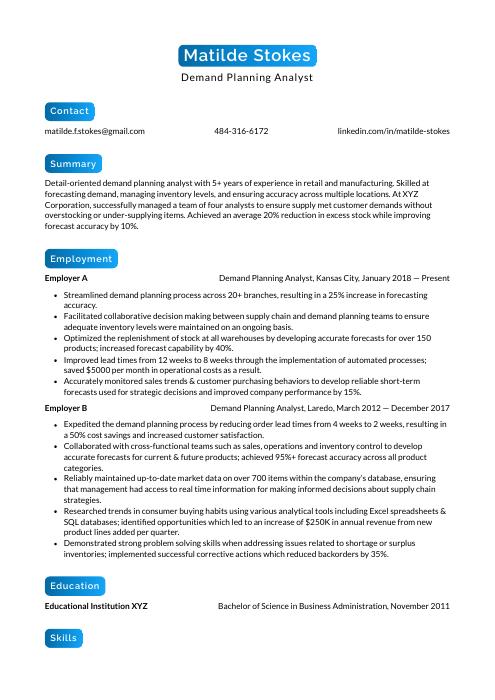 Kinkajou
Kinkajou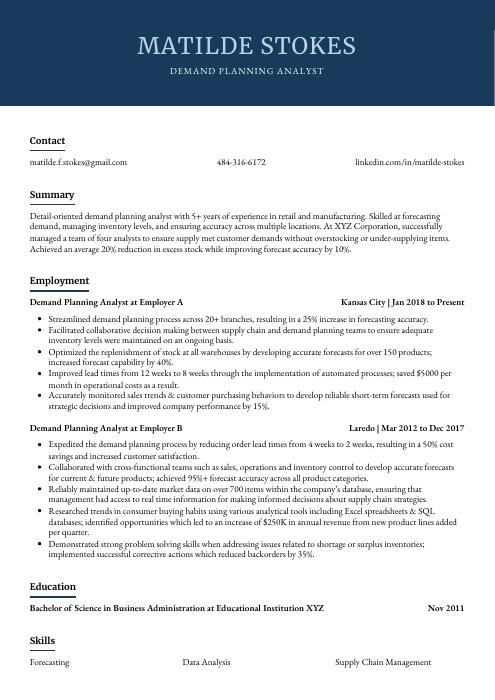 Bonobo
Bonobo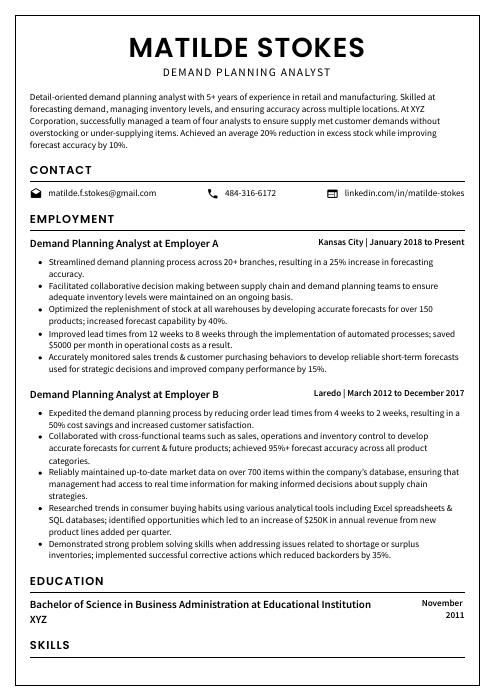 Cormorant
Cormorant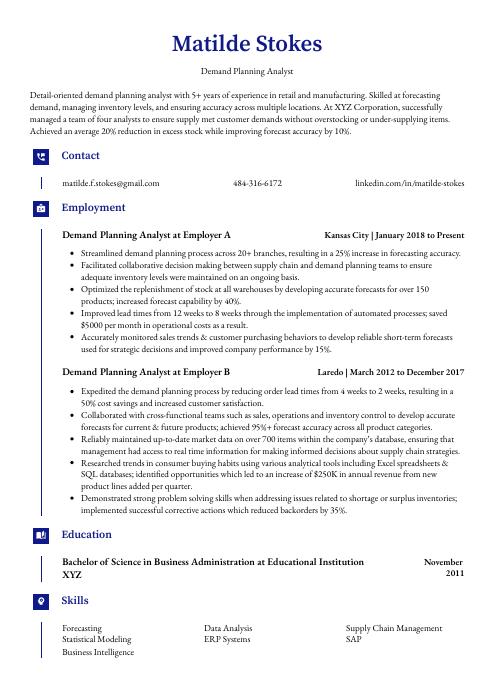 Gharial
Gharial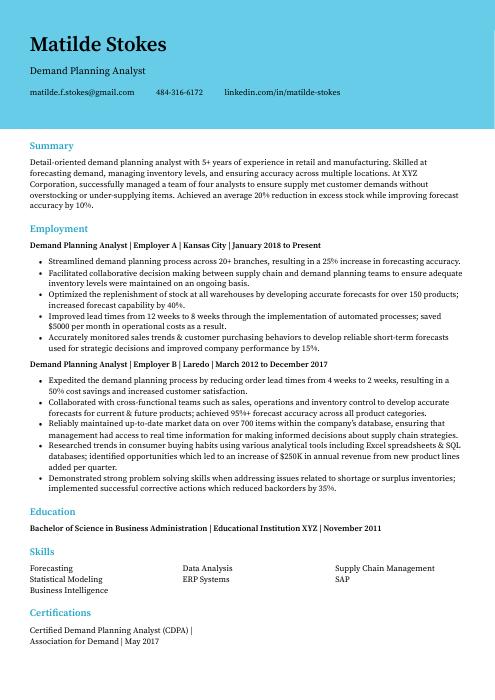 Dugong
Dugong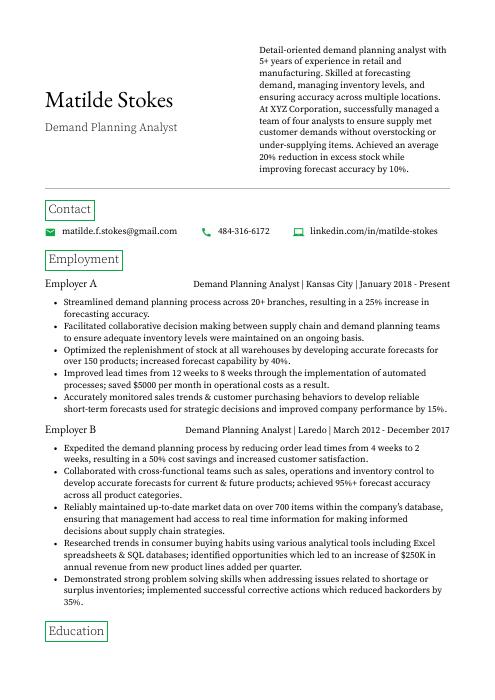 Quokka
Quokka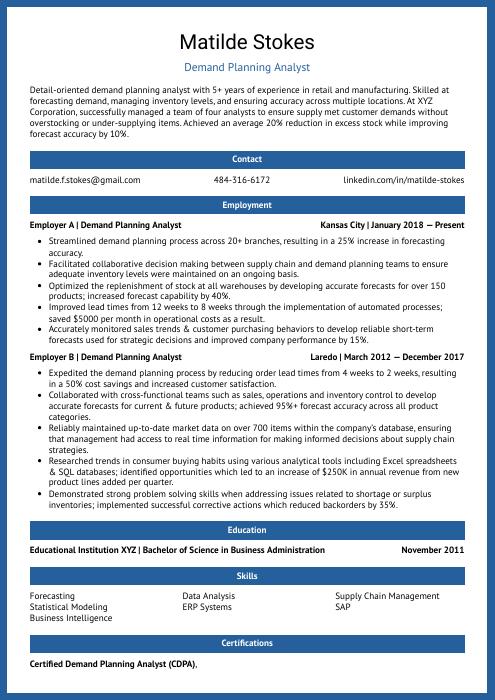 Ocelot
Ocelot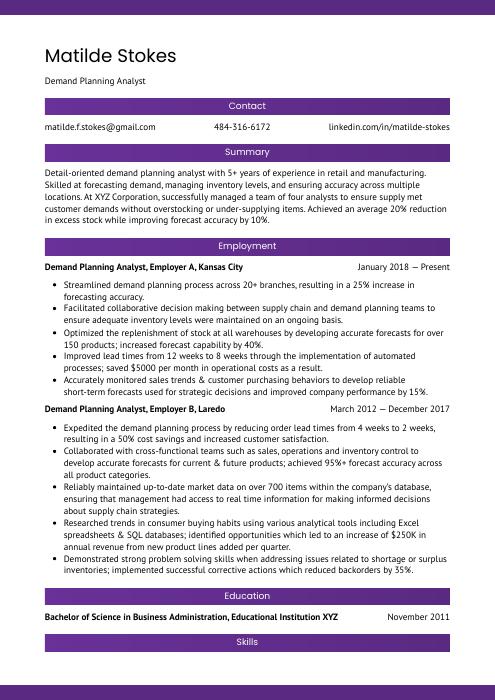 Jerboa
Jerboa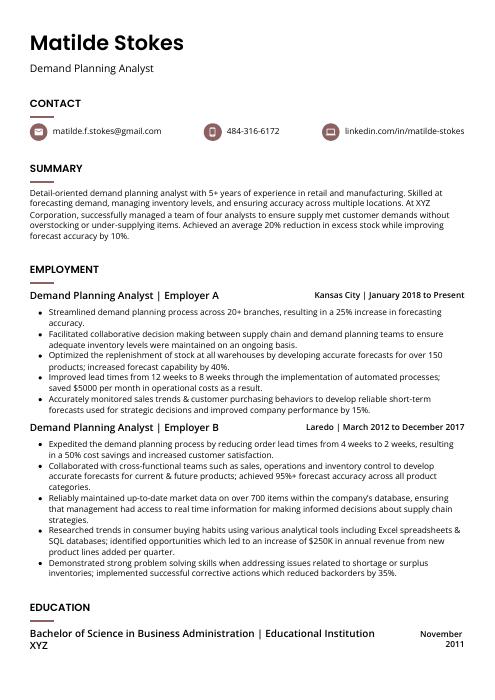 Fossa
Fossa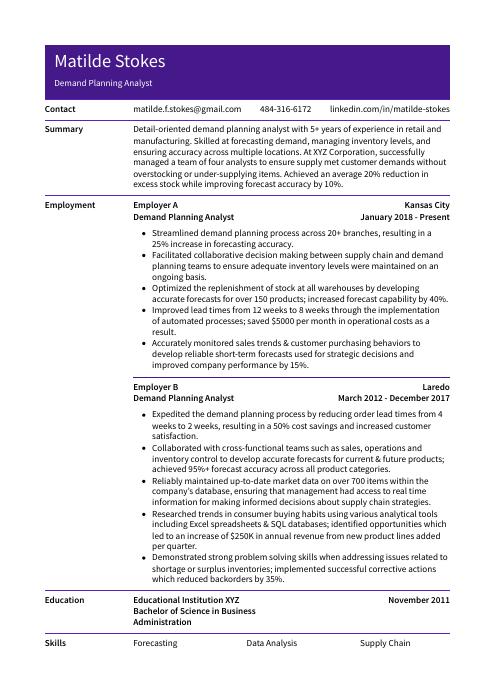 Pika
Pika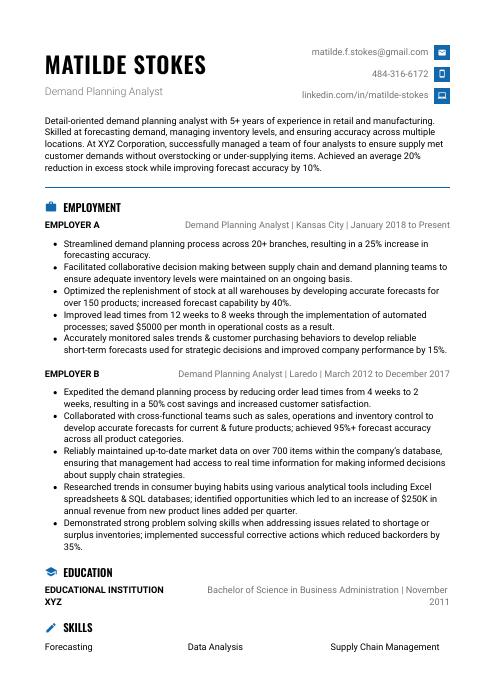 Echidna
Echidna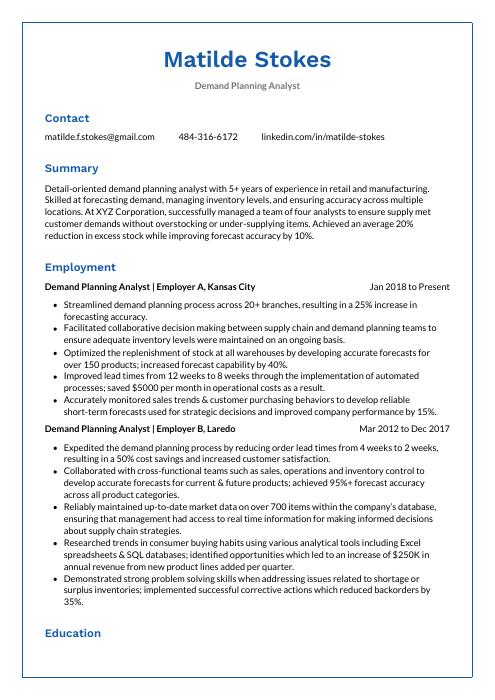 Markhor
Markhor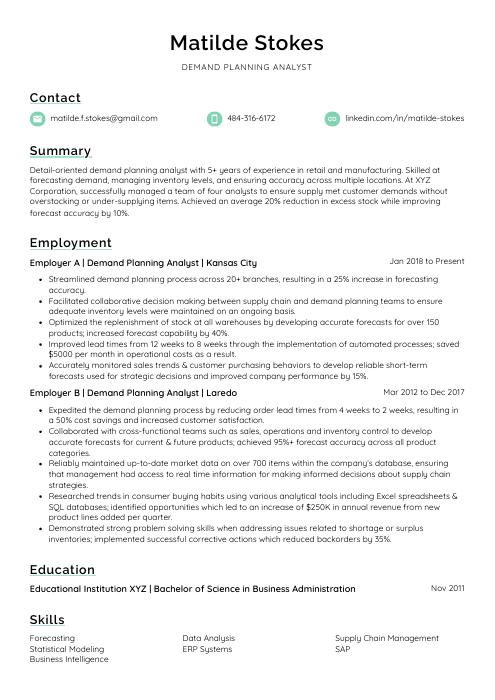 Lorikeet
Lorikeet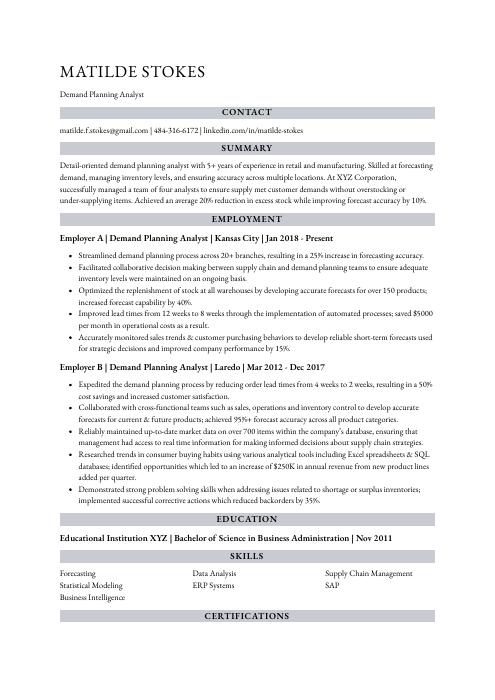 Numbat
Numbat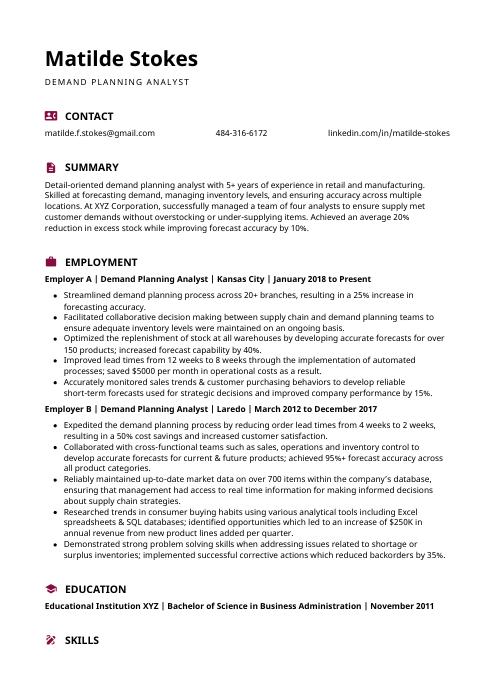 Hoopoe
Hoopoe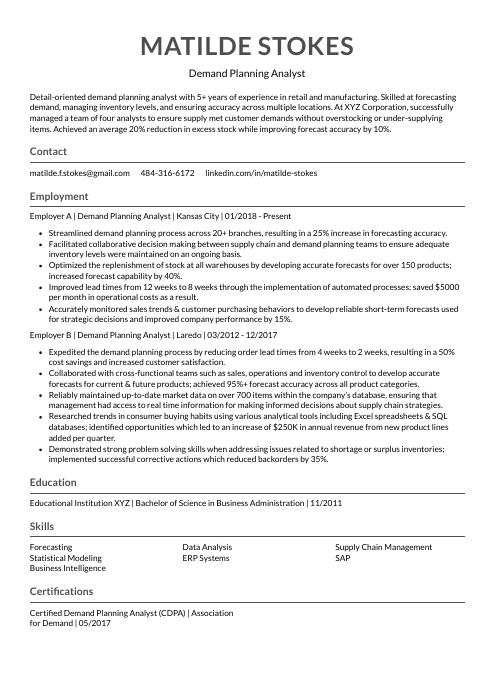 Indri
Indri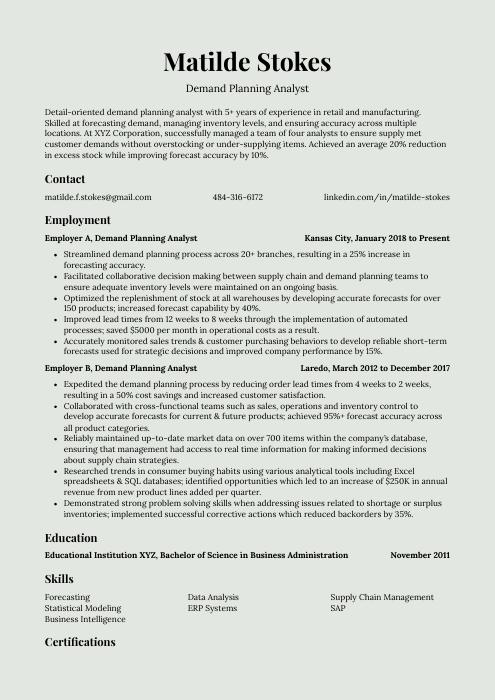 Saola
Saola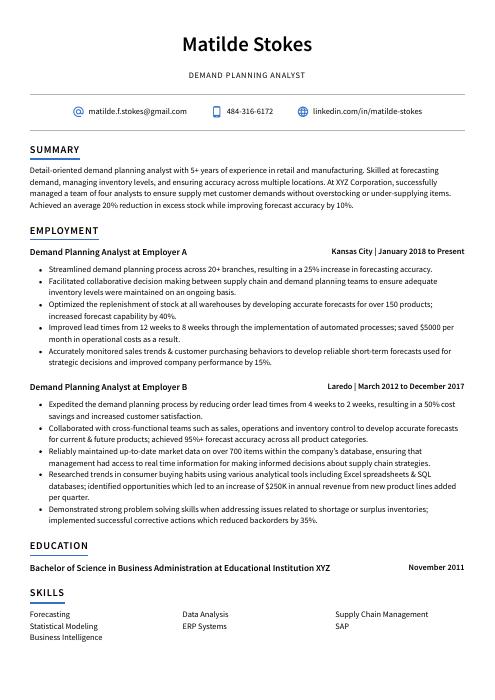 Axolotl
Axolotl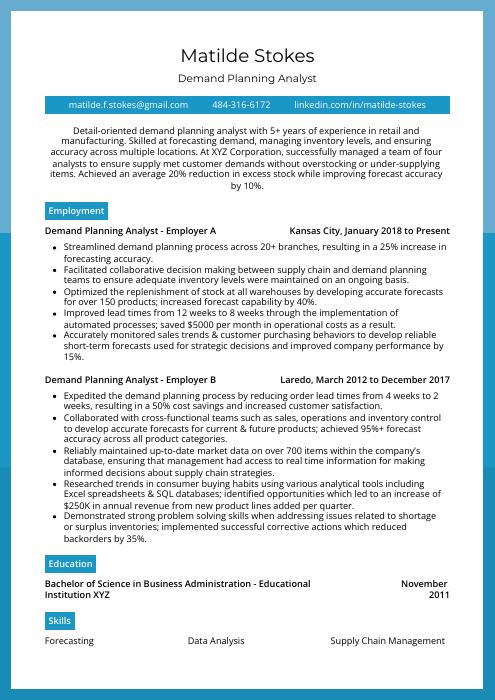 Rhea
Rhea Rezjumei
Rezjumei
